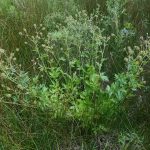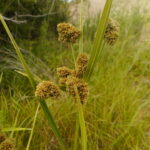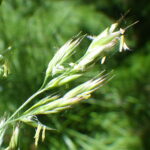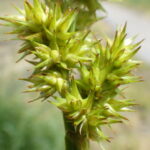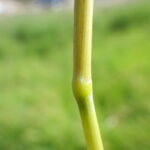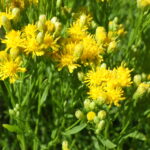HIGHLIGHTS OF HIDDEN SPRINGS WETLANDS WILDFLOWER WALK
mid June through July
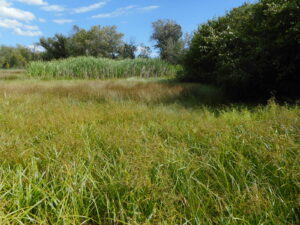
As an alternative to heading to higher elevations for wildflowers during the summer months, when the foothills proper have largely dried out, check our what’s growing in your local wetlands for a whole new suite of interesting plants, some of which are just hitting their stride. The wildflower walk described here, through the exceptionally rich remnant wetlands at Hidden Springs, is the shortest walk in the series, a half-mile ramble that is a pleasant morning or evening outing even on a hot summer day.
Description: The walk as described begins at the main trailhead on the south side of Dry Creek Road between Cartwright Road and Seamans Gulch Road. A trail at the east side of the trailhead cuts south through a selection of marshland habitats to a well-shaded bridge across Dry Creek, where the described portion of the walk ends. Be sure to enjoy the birds as well, and don’t forget your mosquito repellent!
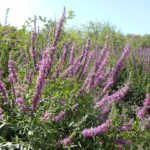
As a generalized introduction, wetland floristics differ from upland floristics in that, thanks to the ease that seeds and other propagules are transported by waterfowl, plant distribution is determined less by geographic range per se and more by water seasonality, depth, and chemistry, as well as how long the wetland habitat has existed. Because of this, the distinction between “native” and “non-native” becomes increasingly problematic for many species, if not outright arbitrary in some cases (does the plant care if it arrived via waterfowl or human agency?) In spite of this, some rare plants do occur as regional endemics, often threatened by wetland invaders that can shove everything else out, given the chance. Among the worst invasive species that are present at Hidden Springs wetlands are purple loosestrife (Lythrum salicaria), mis-named Canada thistle (Cirsium arvense), and reed canarygrass (Phalaris arundinacea).
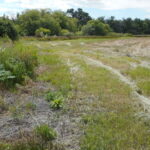
Prior to Euro-American settlement, there were undoubtedly numerous natural wetlands on the fertile flatlands at the base of the foothills, where creeks or springs supported rich meadows throughout the summer months. These would have been prime sites for the earliest homesteaders, who quickly converted the meadows into pastures and farmlands. The very name “Hidden Springs” is a clue that the existing wetlands here are in fact remnants that have persisted from pre-settlement times, among the very few examples in existence locally (Council Springs being another). Even these persisting wetlands have been variously altered; most of the Hidden Springs wetlands are regularly mowed midsummer, except for the central thicket and surrounding areas that harbor the greatest diversity.
The presence of several locally rare plants in the Hidden Springs wetlands bolsters the interpretation of this site as a persisting remnant, in particular the large stands of Nuttall’s cinquefoil (Potentilla gracilis var. fastigiata) and common avens (Geum aleppicum), as well as scattered Macoun’s buttercup (Ranunculus macounii) and pale bulrush (Scirpus pallidus). These are the special “treasures” of this particular wildflower walk; most can be seen from the trail itself, though some might require a stroll along the edge of the mowed area to spot.

Begin your walk at the east end of the parking lot, where you can easily see three conspicuous noxious weeds (if not recently mowed). Large patches of purple-flowered Canada thistle (Cirsium arvense) grow at the edge of the marsh, interspersed with tall stalks of poison-hemlock (Conium maculatum) covered with small white flowers. Field bindweed or wild morning-glory (Convolvulus arvensis) sprawls along the edge of the path, some plants with lovely pink flowers instead of the usual white. Several other relatively showy non-natives are also present, including red clover (Trifolium pratense) and chicory (Cichorium intybus).
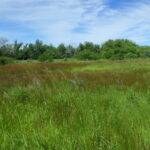
Where the path splits, take the right-hand option to follow the main cattail-lined trail bisecting the marsh. The marsh itself is dominated by members of the three primary families of graminoids: grasses (Poaceae), sedges (Cyperaceae), and rushes (Juncaceae). A popular rule of thumb is that “sedges have edges while rushes are round”; while it is true that 3-angled stems are found only in Cyperaceae, and most rush stems are in fact round, there are also a lot of Cyperaceae with round stems. True grasses differ from both in having hollow stems than are partitioned at regularly spaced nodes; the leaf that arises from each node has a sheathing base and spreading blade. The inflorescence is the real give-away: rushes have small but recognizable six-parted flowers, while grasses and sedges have highly reduced floral parts intermixed with various scale-like structures. In grasses, these are organized into well-defined spikelets that are often bilaterally flattened; the scales of sedges are more often arranged in tightly overlapping spirals.
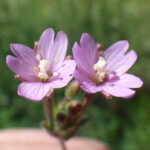
The most abundant rush in the marsh is Baltic rush (Juncus balticus), which tends to form large brownish swaths; plants in the path itself often have spirally twisted stems. One of the most abundant members of the sedge family is common spike-rush (Eleocharis palustris), which has a single narrow inflorescence atop a cylindrical, pith-filled stem. Common wildflowers in the marsh include pinnate-leaved yellow avens (Geum aleppicum) and both pink- and white-flowered forms of the highly variable common willow-herb (Epilobium ciliatum), both finely hairy. Also keep an eye out for Macoun’s buttercup (Ranunculus macounii) growing opposite the first patch of cattails (Typha latifolia), and occasional palmate-leaved Nuttall’s cinquefoil (Potentilla gracilis var. fastigiata).
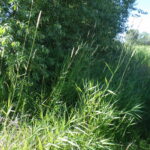
A stand of reed canary-grass (Phalaris arundinacea) grows next to an isolated willow (Salix sp.) on the left; left unchecked, this highly invasive grass can from monocultures in wetlands, reducing diversity and wildlife value. A lone obtuse-leaf rose (Rosa obtusifolia) grows on the right side of the path; compare the hairy leaves to the glabrous leaves of dog rose (Rosa canina) farther down the path. Also keep an eye out for a wet depression on the right with an abundance of water speedwell (Veronica anagallis-aquatica) and Nuttall’s cinquefoil (Potentilla gracilis), surrounded by spikerush (Eleocharis palustris) and panicled bulrush (Scirpus microcarpus).
The path wraps around a thicket consisting primarily of black hawthorn (Crataegus douglasii) and dog rosa (Rosa canina). Among the plants growing at the moist edge of this stretch of path are rabbitsfoot grass (Polypogon monspeliensis), toad rush (Juncus bufonius), jointed rush (Juncus articulatus), and strawberry clover (Trifolium fragiferum) with its curiously swollen fruiting heads. Large clumps of awl-fruit sedge (Carex stipata) are conspicuous just before the thicket; this is one of the more easily identified sedges, along with woolly sedge (Carex pellita) which might also be spotted here. Catnip (Nepeta cataria) grows on the back side of the thicket, where there is also an easily accessible colony of hairy evening-primrose (Oenothera villosa ssp. strigosa). Pale bulrush (Scirpus pallidus) grows near the thicket but is not usually visible from the path.
After paralleling the back side of the thicket for a short distance, the path cuts across a weedy area (possibly mowed) with both yellow and white color morphs of moth mullein (Verbascum blattaria), common mullein (Verbascum thapsus), and unusually pink forms of bindweed (Convolvulus arvensis); also keep an eye out for bracted verbena (Verbena bracteata).
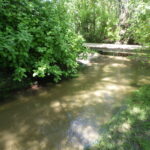
The guided portion of the walk ends in the gallery forest along Dry Creek, where the path crosses a sturdy bridge. Dominant trees and shrubs include black cottonwood (Populus trichocarpa), red-osier dogwood (Cornus stolonifera). interior rose (Rosa woodsii ssp. ultramontana), and various willows (Salix spp.) Look carefully and you might see some common horsetail (Equisetum arvense) and American speedwell (Veronica americana) growing along the creek, and possibly western goldenrod (Eucephalus occidentalis) depending on the season. Turn left after crossing the creek to look for twining wild-cucumber (Echinocystis lobata) and a small patch of stinging nettle (Urtica dioica), whose stinging hairs can give you a rash if you brush against it. Being careful not to touch the stinging nettle, compare it to plants of catnip (Nepeta cataria), which grows next to the bridge; the leaves are somewhat similar, but those of stinging nettle are more sharply toothed, and its tiny wind-pollinated flowers are in tassels.
Continuing wandering on your own from this point, or retrace your steps to the trailhead.
PLANT LIST [updating needed]
Plants listed in alphabetical order by genus within category. *Indicates native species (or at least possibly native; see Introduction to this walk).
WILDFLOWERS
- *Fiddleneck (Amsinckia spp.) – species difficult to distinguish
- Burdock (Arctium minus) – fall-blooming
- Catchweed, madwort (Asperugo procumbens)
- Chicory (Cichorium intybus)
- Wild or prickly cucumber (Echinocystis lobata)
- *Common willow-herb (Epilobium ciliatum) – several pubescence forms present
- *Western goldenrod (Euthamia occidentalis [previously in Solidago]) – fall-blooming
- *Cleavers, bedstraw, stickywilly, goose-grass (Galium aparine)
- *Yellow avens (Geum aleppicum)
- Field pepperweed (Lepidium campestre)
- Common mallow, cheeseweed (Malva neglecta)
- Black medick (Medicago lupulina)
- White sweetclover (Melilotus albus)
- *Yellow monkeyflower (Erythranthe guttata, previously in Mimulus)
- Wild mint (Mentha canadensis)
- Catnip (Nepeta cataria)
- *Hairy evening-primrose (Oenothera villosa ssp. strigosa)
- Common plantain (Plantago major)
- *Nuttall’s or slender cinquefoil(Potentilla gracilis var. fastigiata)
- *Macoun’s buttercup (Ranunculus macounii)
- *Blister buttercup, cursed crowfoot (Ranunculus sceleratus var. multifidus)
- Curlydock (Rumex crispus)
- Strawberry clover (Trifolium fragiferum) – fruiting heads inflated
- Alsike clover (Trifolium hybridum) – flowers pale pink
- Red clover (Trifolium pratense) – flowers rose-pin, subtended by leaves
- *Hairy stinging nettle (Urtica dioica ssp. holosericea) – STINGING HAIRS
- Moth mullein (Verbascum blattaria) – both white- and yellow-flowered forms
- Common mullein (Verbascum thapsus)
- *Bracted verbena (Verbena bracteata)
- *America speedwell or brooklime (Veronica americana) – some leaves short-petiolate
- Water speedwell or pimpernel (Veronica anagallis-aquatica) – all leaves sessile
FERN RELATIVES
- *Common or field horsetail (Equisetum arvense) – along creek
NOXIOUS AND/OR INVASIVE WEEDS (not all in bloom)
- Jointed goatgrass (Aegilops cylindrica)
- Cheatgrass (Bromus tectorum)
- Canada thistle (Cirsium arvense)
- Poison-hemlock (Conium maculatum)
- Field bindweed, wild morning-glory (Convolvulus arvensis) – some pink-flowered
- Mouse or wall barley (Hordeum murinum)
- Purple loosestrife (Lythrum salicaria) – fall-blooming, occasionally sprayed
- Reed canarygrass (Phalaris arundinacea)
- Feral or cereal Rye (Secale cereale)
OTHER GRASSES AND GRASSLIKE PLANTS (partial list)
- Meadow brome (Bromus commutatus)
- *Woolly sedge (Carex pellita, previously in C. lanuginosa) – perigynia hairy
- *Awl-fruit sedge (Carex stipata var. stipata) – perigynia sharply pointed
- *Sedge (Carex spp.) – other species difficult to distinguish
- Orchard grass (Dactylis glomerata)
- *Common spike-rush (Eleocharis palustris)
- *Baltic rush (Juncus balticus)
- *Common toad rush (Juncus bufonius var. bufonius)
- Rabbitsfoot grass (Polypogon monspeliensis)
- *American, three-square, Olney’s, or chairmaker’s bulrush (Schoenoplectus americanus, previously in Scirpus)
- *Panicled or small-fruited bulrush (Scirpus microcarpus)
- *Pale bulrush (Scirpus pallidus)
- *Broadleaf cattail (Typha latifolia)
- Rattail fescue (Vulpia myuros)
SHRUBS, TREES, AND WOODY VINES (mostly not in bloom)
- *Red-osier dogwood (Cornus stolonifera)
- *Black hawthorn (Crataegus douglasii)
- Russian-olive (Elaeagnus angustifolia) – invasive non-native
- Black walnut (Juglans nigra)
- *Black cottonwood (Populus trichocarpa) – other species and/or hybrids possibly present
- *Golden currant (Ribes aureum)
- Dog rose (Rosa canina) – non-native, invasive in some spots
- Obtuse- or round-leaf rose (Rosa obtusifolia) — like dog rose, but leaflets hairy
- *Interior or Wood’s rose (Rosa woodsii subsp. ultramontana) – native, with slender prickles
- *Willows (Salix spp.) – several species locally, most are difficult to distinguish
- *Western poison-ivy (Toxicodendron rydbergii, alternatively Rhus radicans) – CAUSES DERMATITIS
